Gallery: Glowing Aquatic Life
Brilliantly Bioluminescent Fish
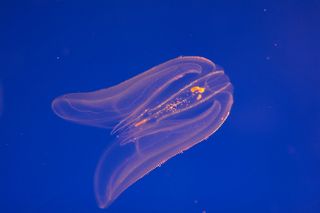
Bioluminescence, or when light is produced by an organism using a chemical reaction, most commonly occurs in sea creatures. This dazzling glow-in-the-dark display can be used for communication, to attract prey, distract predators or even as a defense tactic.
Red-Glowing Highcrest Triplefin Fish
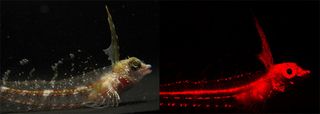
The red fluorescence of the highcrest triplefin fish, or Enneapterygius pusillus, can be seen when looking through a red filter (right). The fish appears a dull grey color under natural light. Fluorescence occurs when light is absorbed at one wavelength and then re-emitted at another nearly immediately. In the case of red fluorescence, highcrest triplefin fish absorb light at blue-green wavelengths and re-emit it at red. Scientists from the University of Tübingen, Germany, discovered the glowing-red fish by chance during dives in Mangrove Bay in the Red Sea (the salt water inlet between Africa and the Arabian Peninsula).
Eight-Armed Glowing Squid
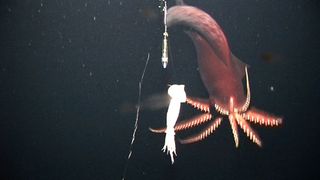
The deep-sea eight-armed squid Taningia danae is the world's largest bioluminescent, or light-emitting, creature. The largest known specimen of the squid can grow up to 7.5 feet long and 130 pounds, with eyes the size of large grapefruits. The T. danae squid emits short, bright light flashes from large glowing organs at the tips of its tentacles. Researchers from Japan's National Science Museum in Tokyo speculate that these flashes might be used to blind prey or help the squids measure the distance to their targets in the dark depths of the sea.
Clever Cookiecutter Shark
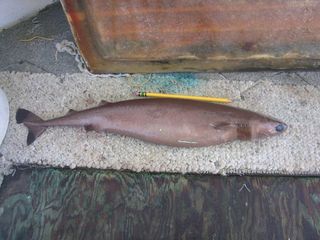
The cookie-cutter shark (Isistius brasiliensis) uses bioluminescence to deceitfully attract its prey. The belly of the shark is covered with thousands of light-emitting photophores, which disguise it by making it blend in with the sunlight shining through the water's surface when the shark is viewed from below. However, the shark does have one unlit patch on its underside, near its throat. To the fish below it, the patch makes the cookie-cutter shark look like a much smaller, dark fish. When confused predators swim up to eat the small fish, the shark takes a quick bite out of them instead, using its saw-like lower teeth to leave an almost perfectly round bite mark. Having attained a snack, the cookie-cutter shark then flees and waits for the next sucker to swim along.
The Blackdragon Fish
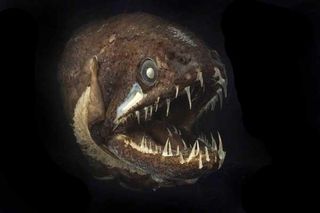
This blackdragon fish's (Melanostomias bartonbeani) bioluminescence serves many useful purposes. It has light-emitting organs arranged all along its belly that fool predators by changing the fish's silhouette. The luminous organs, which are also embedded in its gelatinous dermis and between its fins, light up when the fish is sending out signals to other blackdragon fish. The fish also has bioluminescencant "flashlights" next to each eye that it can flash on while on the look-out for prey or to signal potential mates. A glow-in-the-dark chin barbel serves to attract and lure in prey. The blackdragon fish sure knows how to get the most out of its bioluminescence!
Mesmerizing Jellyfish
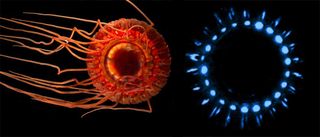
A deep-sea jellyfish, the Atolla wyvillei sends out a rotating pinwheel of blue light that illuminates around the circumference of its body as a "burglar alarm." That is, when a predator has the jellyfish in its clutches, the Atolla wyvillei emits the bright, flashing circular light patterns in hopes of attracting an even bigger predator to attack the original predator. If the jellyfish's burglar alarm plan works, their original predator will let go and swim away out of fear. Or the attacked predator may loosen their grip on the jellyfish, providing it a chance to escape.
The Anglerfish
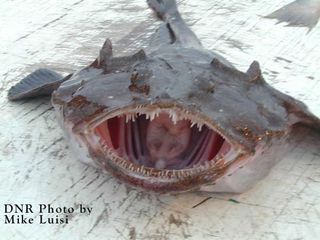
The anglerfish grows its own special bioluminescent bacteria to attract prey. The scary-looking fish uses a luminescent lure packed with glowing bacteria that hangs just above and in front of its toothy face. But it's only the females that have this "fishing pole," which is actually a piece of dorsal spine containing millions of glow-in-the-dark bacteria. Yes, the anglerfish is the very same deep-sea fish that terrorized Nemo and Dory in Pixar's "Finding Nemo." There are more than 200 species of anglerfish, many of which live at the bottom of the Atlantic and Antarctic oceans. Above is one of the species, the ferocious-looking monkfish.
Sign up for the Live Science daily newsletter now
Get the world’s most fascinating discoveries delivered straight to your inbox.
Lanternfish
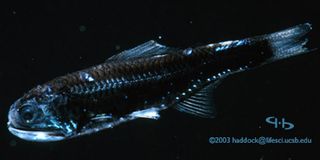
There are more than 240 species of Myctophids, which are also known as lanternfish or lampfish. There are so many of them that they are thought to be some the most common deep-sea creatures. Lanternfish mostly feed on plankton, and follow the tiny organisms' daily migration by spending the day at the bottom of the sea and coming close to the water's surface at night. The lanternfish's luminescent organs, called photophores, are pale green or blue and are located on the fish's head, underside, and tail. The distribution of their light organs follow a design that is species-specific, with each species lighting up in a different pattern. This variation could be helpful for when lanternfish are attempting to attract and recognize potential mates.
Most Popular




